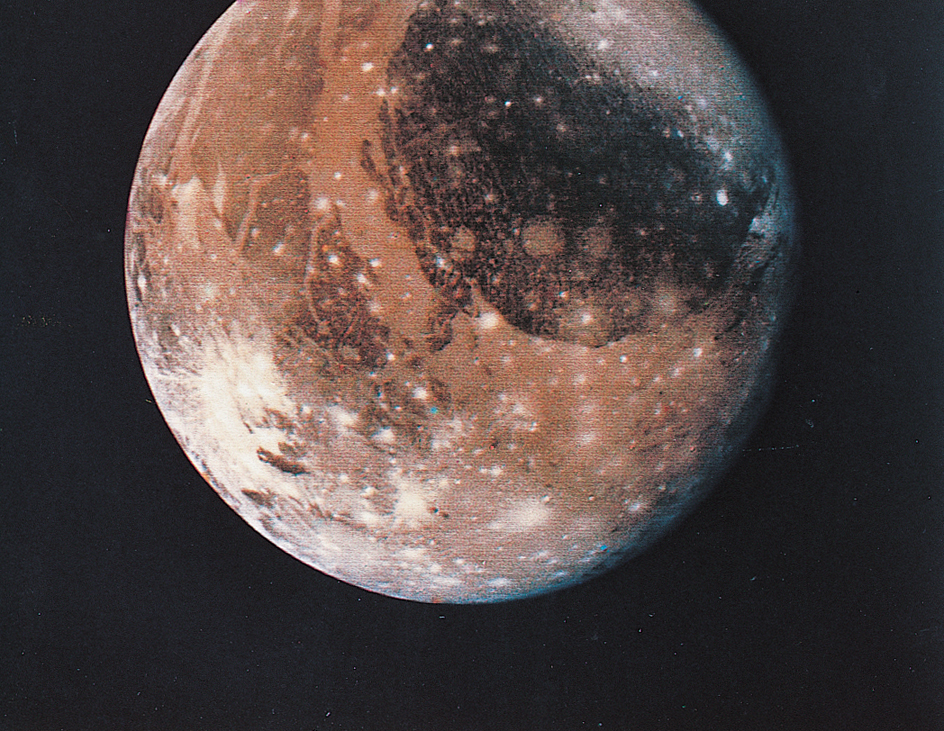Ganymede << GAN uh meed >>, a satellite of Jupiter, is the largest moon in the solar system. It is even larger than the planet Mercury. Ganymede is 3,270 miles (5,262 kilometers) in diameter—about as wide as China and three-fourths the diameter of Mars. Ganymede is a rocky, icy moon with a vast subsurface (underground) ocean. Scientists think Ganymede’s ocean is 10 times as deep as the ocean on Earth.
Ganymede is the only moon in the solar system known to have its own magnetic field. A magnetic field is the influence that a magnet or electric current creates in the region around it. Ganymede’s magnetic field may be generated by the flow of molten metal in its core. Jupiter’s large, powerful magnetic field completely encloses Ganymede’s magnetic field.
Ganymede orbits Jupiter once every 7.15 days at a distance of 664,900 miles (1,070,000 kilometers). Because it is far from the sun, and because its atmosphere is too thin to trap much heat, Ganymede’s surface is cold. During the daytime, temperatures range from -297 to -171 °F (-182 to -113 °C).
Structure.
Ganymede’s upper one-third is ice, except for an ocean of salty water about 100 miles (160 kilometers) beneath the surface. The core is rock and metal. The innermost part of the core is rich in iron.

Ganymede’s thin atmosphere is thought to contain oxygen and hydrogen. Telescope observations suggest the atmosphere may also contain water vapor. Like Earth, Ganymede experiences auroras, striking light displays produced when energetic particles from the moon’s magnetic field collide with particles in its atmosphere.
Ganymede’s surface is made up of approximately equal amounts of dark and bright terrain. The dark areas are composed mostly of ice mixed with pieces of dark rock. These areas have many craters and large cracks. The craters have resulted from impacts by asteroids and comets. The cracking occurred after Ganymede formed billions of years ago. Forces released by the biggest impacts produced many of the cracks. Other cracks occurred when changes in the moon’s structure and temperature caused it to expand.
The bright terrain is much less cratered. It formed as the surface expanded and cracked. Icy water flooded the resulting depressions and any craters that were present. Further cracking and stretching of the new terrain created parallel sets of ridges and valleys.
Scientists estimate that Ganymede’s ocean forms a layer about 60 miles (100 kilometers) thick. The ocean layer may consist of several thin, alternating layers of ice and liquid water. Experts think the subsurface oceans of Ganymede and similar moons may provide the conditions necessary for life to develop. But no evidence of life has yet been discovered on these moons.
History of study.
In 1610, the Italian astronomer Galileo discovered Jupiter’s four largest moons: Ganymede, Callisto, Io, and Europa. These are known as Jupiter’s Galilean moons. The Galilean moons can be seen in the night sky with a pair of binoculars or a small telescope. All four were named after characters in Greek mythology. The Galileo spacecraft, launched by the United States National Aeronautics and Space Administration (NASA), studied Jupiter and its moons from 1995 to 2003. Scientists used Galileo to discover Ganymede’s magnetic field. In 2002, Galileo’s measurements provided the first direct evidence that Ganymede had a subsurface ocean. The spacecraft also found gravitational irregularities that scientists think are caused by large, dense rock formations underneath Ganymede’s crust. Astronomers have also used the Hubble Space Telescope to study Ganymede. In 2015, astronomers used Hubble to estimate the size and depth of Ganymede’s ocean. Because the ocean contains salt water, it conducts electricity, which affects Ganymede’s magnetic field. Hubble photographed Ganymede’s auroras to track the moon’s changing magnetic field. Hubble has helped astronomers confirm discoveries made with Galileo data. NASA’s Juno mission, which reached Jupiter in 2016, took high-resolution photos of Ganymede and close measurements of its magnetic field. In 2021, the spacecraft’s mission was extended to include further study of Ganymede, Europa, and Io that would involve several close flybys. Ganymede is an important target of the European Space Agency’s JUICE mission, launched in April 2023. JUICE is short for Jupiter Icy Moons Explorer. The JUICE spacecraft will visit Europa, Callisto, and Ganymede. JUICE is expected to reach Jupiter in 2031 and enter orbit around Ganymede in 2034. If the mission succeeds, JUICE will become the first spacecraft to orbit a moon other than Earth’s moon.
